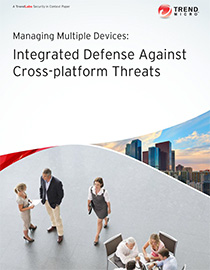Managing Multiple Devices: Defend Against Cross-Platform Threats in the Workplace
 View primer: Managing Multiple Devices: Integrated Defense Against Cross Platform Threats
View primer: Managing Multiple Devices: Integrated Defense Against Cross Platform Threats
Looking into changing IT environments? Security experts warn that adopting new device types and computing platforms without proper control comes with a price.
It's become common for companies to let their employees use personal devices for both work and leisure. Granting this freedom has its benefits. An employee armed with his own smartphone and tablet for work increases productivity. Communication is faster, and the flexibility provided by personal devices makes accessing and sending out company data a lot easier. Employee satisfaction is also raised since the device specifications and the apps installed more or less meet each employee's preferences.
However, allowing the use of employee-owned devices in the workplace opens up a company’s network to security risks like vulnerabilities and malware. Now if you multiply those risks to the number of devices in an enterprise, you’ve got a complex computing environment that needs securing.
Enterprises might fail to see this problem. This oversight could lead to real-life business risks that have the potential to harm the company’s integrity or halt the business altogether. Cross-platform malware, for instance, can be used to expose confidential data stored in mobile devices. Given its nature, the malware is platform agnostic. This means it can infiltrate various devices running on different platforms. Traditional security solutions perform poorly against these kinds of threats.
It also doesn’t help that patching is still an issue for consumer-grade devices. Having unpatched devices access the company’s network increases the probability of getting exploited.
In a blended computing environment like this, enterprises need to consider taking on a data-focused approach to security. IT departments will have to deal not only with security concerns but also with resource issues. Defending against cross-platform threats involves patching each and every device, blacklisting threats known to target device vulnerabilities, and upgrading to the latest software. This will require stringent policies, time and resource allocations, and manpower.
The attached paper on Managing Multiple Devices further lists which security technologies are best integrated to successfully execute this approach.Like it? Add this infographic to your site:
1. Click on the box below. 2. Press Ctrl+A to select all. 3. Press Ctrl+C to copy. 4. Paste the code into your page (Ctrl+V).
Image will appear the same size as you see above.
Recent Posts
- Estimating Future Risk Outbreaks at Scale in Real-World Deployments
- The Next Phase of Cybercrime: Agentic AI and the Shift to Autonomous Criminal Operations
- Reimagining Fraud Operations: The Rise of AI-Powered Scam Assembly Lines
- The Devil Reviews Xanthorox: A Criminal-Focused Analysis of the Latest Malicious LLM Offering
- AI Security Starts Here: The Essentials for Every Organization

 Complexity and Visibility Gaps in Power Automate
Complexity and Visibility Gaps in Power Automate AI Security Starts Here: The Essentials for Every Organization
AI Security Starts Here: The Essentials for Every Organization The AI-fication of Cyberthreats: Trend Micro Security Predictions for 2026
The AI-fication of Cyberthreats: Trend Micro Security Predictions for 2026 Stay Ahead of AI Threats: Secure LLM Applications With Trend Vision One
Stay Ahead of AI Threats: Secure LLM Applications With Trend Vision One